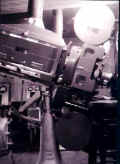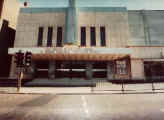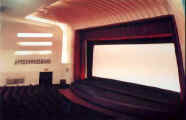Wide Screen Movies Magazine
edited by John
Hayes
Answer:- When it was CinemaScope!
By Bill Blaney
Belfast's largest cinema, the ABC Ritz, had not yet installed the big screen, being the main exhibitor of Warner and MGM product. But within a short time its advertising announced that all of its future attractions would be shown on the "Giant Wide Screen". This was nothing more or less than masking the top and/or the bottom of the picture (in the aperture) to give an aspect ratio of 1.66:1, and enlarging the whole thing to fill a wider screen. This became common practice throughout the industry, and within a short time, most producers began shooting their films with all the significant action kept well away from the top and bottom of the frame, MGM being one of the first. Their lion trademark was redesigned to properly fit in the reduced- height frame. Older films projected in this format often suffered from the loss of actors' heads or feet. Apparently one of the first victims was Shane, which had been carefully composed virtually frame by frame in the old 1.33:1 format by top cinematographer Loyal Griggs. Re-releases became a projectionist's nightmare; correct framing of credit titles and some sequences being sometimes almost impossible. One of the most difficult was Disney's Pinocchio, where Monstro the Whale had to lose either his flippers or his spout!
CinemaScope was eventually installed in almost every Belfast cinema, though the majority refused to pay for 20th Century-Fox's four-track magnetic sound or its "Miracle Mirror" Screen. The Curzon was one of these, having a forty-two foot matt screen to cover all the seats in its fairly wide auditorium. The panel controlling the automatic screen masking had three settings, one for CinemaScope at forty feet, VistaVision at thirty five feet and the narrowest, Widescreen*, at thirty feet. VistaVision and Widescreen were projected through the same lenses, the focal length of which would be changed to the appropriate setting, as was the aperture plate in each projector
*This masking of the picture to 1.66:1 or even 1.85:1 is what projectionists of the day referred to as "Widescreen". The term was not applied to either CinemaScope or VistaVision until the advent of widescreen television - B.B.

Interior and exterior of the Curzon before it was "tripled" in 1982, then "quadrupled" in 1986 and subsequently "quintupled" in the nineties - it's closed now, of course!
In addition to his main article, Bill was able to supply us with a number of vignettes, concerning particular films, which I thought you might like to see, so read on…
J.H.
This was the title of one of the most unusual widescreen films. Indeed, as far as I know, it was the only one of its kind. It was advertised as being in "Duovision" and the entire film was made up of two, usually complementary, pictures positioned side by side in the CinemaScope frame. Despite the entirely forgettable plot, the story-telling technique seemed to work fairly well. The film was released by MGM and ran for 96 minutes. It played the Curzon, Belfast in March 1974 as the second-feature to the same company's Pat Garrett And Billy The Kid.
Gone With The Wind (MGM)
In 1968 the ABC Belfast played a reissue of Selznick's epic, which for this release had been enlarged to 70mm and provided with six-track magnetic stereophonic sound. It was said that some close-ups had been replaced by similar long-shots unused in the original, and that each scene had been carefully masked to fit the new aspect ratio without losing vital information. The letters of the main title were reduced in size for the same reason, but the rest of the credits presented no problem as they rolled upwards on the screen anyway. Most of the film stood up fairly well to its enlargement and "widening", though in one or two scenes definition was decidedly soft.
Pathe News
Does anybody remember widescreen newsreels? Does anybody remember ANY newsreels!!? Some time in 1964 Associated British-Pathe issued at least a couple of colour editions in Techniscope. One of these covered some of the Pope's travels; another was devoted to the Beatles. The process was a genuine widescreen system, devised by Technicolor, in which the camera used a two-perforation pull-down as opposed to the standard four and recorded an undistorted 2.35:1 image in the half-frame on 35mm film. During printing, the picture was optically stretched vertically to fill a four-perforation frame. When projected through an anamorphic lens, the picture was restored to its original shape and filled the CinemaScope screen. The advantages were that only half the amount of colour negative film was required, and a wider range of lenses could be used on the camera. On the downside, the smaller negative area could result in a grainier image, but, in fact, this was seldom apparent and many feature films were made in the process.
South Pacific (20th Century-Fox)
In 1961, the Curzon was the first Belfast cinema to show Rodgers and Hammerstein's musical in 35mm, some months after its long Todd AO run at the city-centre Ritz. We were warned in advance that despite having only an optical soundtrack, the 'scope picture was printed on film stock which had the original "Foxhole" perforations, normally used to make room for four magnetic tracks. The projectors had to be fitted with new sprockets and the film-locating pins on the splicers filed to accept the smaller holes. But what we were not told was that for some reason, possibly something to do with its reduction from 70mm, every splice in the negative had produced a broad white flash at the top and bottom of the screen. It was too late to replace the aperture plates, so over the course of the first day's two showings, every flash was laboriously and carefully blacked-out using Filmtone fluid, a type of "ink" used to "bloop" noisy joins as they passed through the soundhead. The top screen masking was lowered about a foot, and the now black "flashes" passed unnoticed on the black felt. The film was enjoyed by full houses for the two-week run so the effort had proved worthwhile
J.H.


